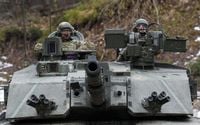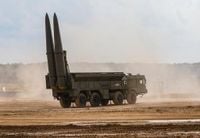In recent months, the geopolitical landscape in Europe has shifted dramatically, particularly in response to Russia's military capabilities and the ongoing conflict in Ukraine. According to Ukrainian intelligence, Russia is producing a staggering number of missiles each month, including 40 to 50 Iskander missiles, 30 to 50 Kalibr missiles, and over 50 Kh-101 missiles. This level of production translates to an annual output of approximately 750 Iskander ballistic missiles and around 560 Kh-101 cruise missiles. Such figures underscore the pressing security concerns faced by European nations, particularly those bordering Russia.
Ukrainian intelligence estimates that Russia's arsenal comprises about 350 Kalibr missiles, 500 Onyx medium-range missiles, over 50 Kinzhal ballistic missiles, and 130 Iskander missiles, among others. Andrij Yusow, a spokesperson for Ukrainian intelligence, noted that the Russians are "devoting a lot of attention to planning and reconnaissance," indicating a strategic approach to resource utilization. Despite the ongoing war, Russia maintains a steady inventory of missiles, and its production capacity allows for the manufacturing of dozens of each type monthly.
Amid these developments, Baltic defense officials have jointly urged NATO countries to accelerate efforts to rebuild their military capabilities and defense sectors. They warn that once the active phase of the war concludes, Russia could reposition its forces, increasing the threat to Eastern NATO members.
In response to these threats, the question arises regarding European missile production capabilities. Assessing these capabilities is challenging, as European companies are often reluctant to disclose production data. Analyst Fabian Hoffman from the University of Oslo has attempted to estimate France's initial SCALP-EG missile production capacity at around 150 missiles per year. However, he suggests that due to declining orders, the actual production may have decreased to about 100 missiles annually.
In November 2024, France announced a commitment of 2 billion euros to replenish its SCALP-EG missile stockpiles. While this investment aims to bolster capacity, Hoffman believes that rapid expansion of production capabilities is unlikely, suggesting that France may only achieve a production level of around 100 missiles per year.
Adding to the complexity, the European Commission recently decided to exclude the United Kingdom from the 150 billion euro ReArm Europe program, a move that has sparked outrage in British media. The decision stems from an unresolved dispute over French fishing rights in the waters surrounding the UK. This exclusion could hinder the production capabilities of European missile systems, as the largest European defense contractor, MBDA, relies on components produced in the UK.
Regarding the Taurus missiles, which are a joint venture between MBDA and Sweden's Saab, Hoffman's analysis suggests that the production capacity ranges from 50 to 100 missiles annually. Production lines were halted in 2010 and took two years to restart, with Spain ordering only 43 Taurus missiles in the subsequent years. Consequently, it is unlikely that production levels have returned to those seen at the beginning of the millennium.
With the ongoing threats from Russia, the production capabilities of European nations are under scrutiny. Current estimates suggest a maximum production capacity of around 200 medium and intermediate-range missiles per year across Europe. In contrast, Ukraine is reportedly on track to produce 3,000 cruise missiles and an unspecified number of Neptun ballistic missiles in 2025, potentially positioning itself as a significant missile producer in Europe.
Norway has also been active in enhancing its defense capabilities, recently announcing a substantial investment of 4.8 billion kroner in Kongsberg's production capacity. This investment is expected to yield results by 2027, with Kongsberg signing agreements with several countries for the supply of 13 NASAMS batteries, with half already delivered by February 2025. The production rate is expected to remain at 3-4 batteries annually in the coming years.
As the geopolitical landscape continues to evolve, the significance of European missile production capabilities has gained heightened importance. Lotje Boswinkel from the Centre for Security, Diplomacy and Strategy at Vrije Universiteit Brussels emphasizes that European countries must enhance their capabilities to conduct precise strikes against targets deep within enemy territory. She argues that the current lack of such capabilities stems from a historical division of labor among NATO allies, where the U.S. maintained long-range strike capabilities.
To strengthen conventional deterrence, Boswinkel identifies three critical weaknesses that European nations must address: increasing the number of missiles in their arsenals, expanding industrial production capabilities, and reforming the so-called "kill chain" architecture. The current deficiencies in these areas are a direct result of the NATO allies' division of responsibilities.
In recent years, European countries have undertaken various initiatives to address these gaps, including the European Long-Range Approach, which involves several nations acquiring missiles with ranges of 1,000 to 2,000 km. However, tangible results from these initiatives are not expected until around 2029-2030, leaving a significant capability gap in the interim.
Despite the challenges, Boswinkel believes that the likelihood of Russia initiating a "great war" with NATO is low, particularly given the substantial losses Russian ground forces have sustained in Ukraine. However, she warns that aggressive actions may still occur under a "salami strategy," where Russia conducts localized attacks near its borders.
In light of the potential weakening of U.S. conventional deterrence in Europe, European nations must prioritize the deployment of missile systems closer to the front lines. Boswinkel argues that convincing European allies of the necessity of this strategic shift should be a primary focus of Polish diplomacy.


